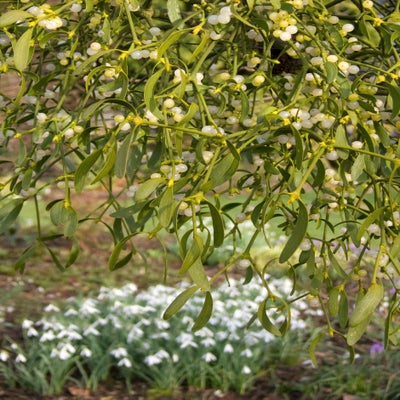
Quick facts
Common name - Mistletoe
Botanical name - Viscum album
Group - Parasitic evergreen shrub
Sowing time - February to March
Height and spread - Up to 2m (6½ft) height and spread
Aspect - Any
Hardiness - Fully hardy
Difficulty - Moderate
How does mistletoe grow?
Mistletoe is a semi-parasitic plant that absorbs and water from a host tree, but also produces its own food through . Small infestations do little harm, but large colonies can significantly weaken host trees.
The most common host in the UK is apple, but lime, hawthorn and poplar are also frequent hosts. Mistletoe is widespread, but scattered, in England, with a stronghold in the south-west midlands and the southern Welsh borders. It is rare in the rest of Wales, Scotland and Ireland.
Berries are naturally spread from one tree to another by birds, especially thrushes and blackcaps, though many plants were probably started by gardeners or fruit growers – sixty percent of mistletoe colonies occur in gardens or orchards.
Harvesting and buying mistletoe
Mistletoe is popular at Christmas, and can be safely cut back quite hard to provide branches for decoration. Do be aware, however, that you would need to gain the landowners permission before gathering any. Mistletoe contains toxic compounds, so it’s safest to wear gloves when handling it, and to keep it out of reach of children and pets.
Most mistletoe on sale comes either from the UK or elsewhere in Europe. Look for plants that are freshly gathered (if necessary, ask when it was harvested), with fresh green foliage and ripe white berries that are plump and not withered.
Mistletoe will keep for two to three weeks after gathering if it is kept in a cool place such as a shed or garage. If you intend to ‘sow’ the berries later, keep branches in the light or the seeds will die.
How to grow your own mistletoe
If you have a suitable host tree it is simple to ‘sow’ mistletoe seed, but it is very slow growing at first, and likely to take up to seven years before fruiting. Both male and female plants are needed to produce berries.
Here is a step-by-step guide to the process:
- Choose ripe berries. Use mistletoe berries when they’re soft and squishy, typically in late winter to early spring (February to March). Avoid hard or immature berries – those from Christmas decorations are often unripe.
- Select a suitable host tree. Apple, including crab apple, lime and poplar are ideal hosts, but mistletoe can grow on many species. You don’t need to match the tree to the species the berry came from. Avoid using very young or unhealthy trees.
- Extract the seed. Gently squeeze the berry to release the sticky seed. Discard any crushed or dried-out berries.
- Pick the right branch. Choose a smooth thin branch, about the thickness of a pencil or your forefinger. Avoid thick, rough or damaged branches.
- Ensure good light. Mistletoe seeds are green and photosynthetically active. Place them in well-lit areas, avoiding heavily shaded branches, to help them establish.
- Apply the seed. Do not cut the or create flaps. Simply wipe the seed onto the underside of the branch, where dew collects naturally. Do not cover the seed, but label the branch so you know where to check for signs of growth.
- Sow multiple seeds. Ripe seed should germinate well, but the slow-growing are very vulnerable so plant several at each site to increase your chances. Both male and female plants are needed for berries to form.
- Be patient. can take months, and at first only a tiny shoot appears, which curls over and penetrates the bark of the host. Leaves may not appear for two or three years, and flowers – which are yellow-green, tiny and open in early spring – need two or three years more.

Problems
Mistletoe is generally free of pests and diseases.
If your propagated mistletoe produces flowers but no berries it is either a male plant, or a female with no males within insect-pollinating distance. Where this appears to be the case, try putting more seeds on the branches to see if you can even out the balance between male and female plants.







